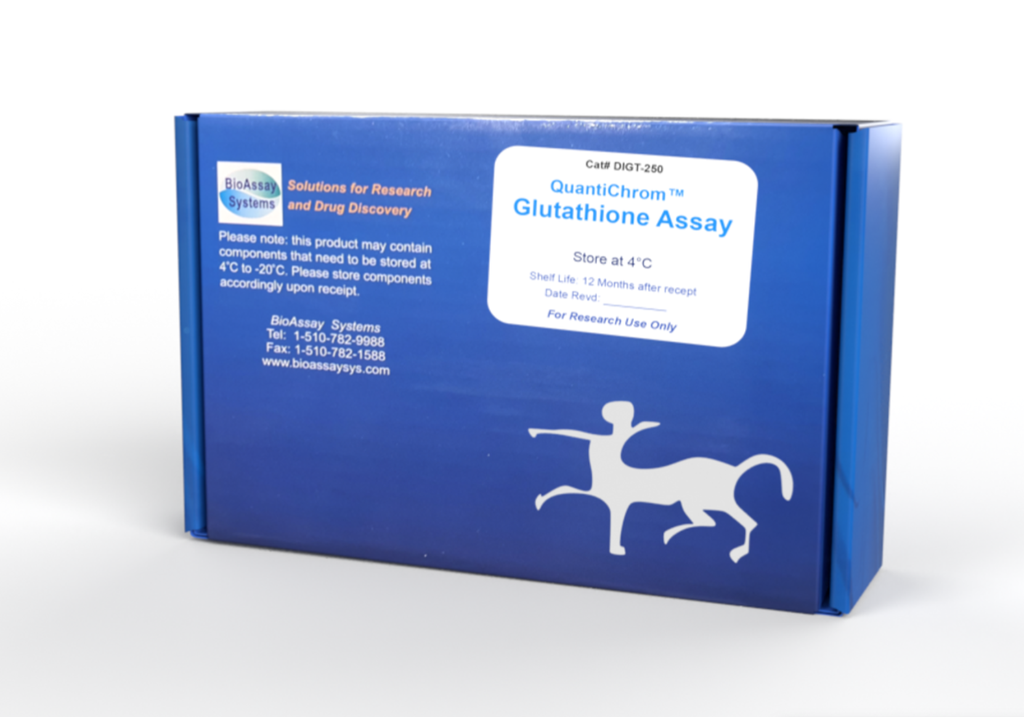DESCRIPTION
Glutathione is a tripeptide of glycine, glutamic acid and cysteine. In the red blood cell, the reduced form of glutathione is vital in maintaining hemoglobin in a reduced state and hence protecting the cells from oxidative damage. Glutathione is involved in detoxification of hydrogen peroxide through glutathione oxidase. Low levels of glutathione are found in deficiencies of key enzymes involved in glutathione metabolism, such as glucose-6-phosphate dehydrogenase, glutathione synthase and glutathione reductase.
Simple, direct and automation-ready procedures for measuring reduced glutathione are becoming popular in Research and Drug Discovery. BioAssay Systems' QuantiChromTM Glutathione Assay Kit is designed to accurately measure reduced glutathione in biological samples. The improved 5,5'-dithiobis(2-nitrobenzoic acid (DTNB) method combines deproteination and detection (Reagent A) into one reagent. DTNB reacts with reduced glutathione to form a yellow product. The optical density, measured at 412 nm, is directly proportional to glutathione concentration in the sample. The optimized formulation has a long shelf life and is completely free of interference due to sample turbidity.
KEY FEATURES
Sensitive and accurate. Linear detection range 0.4 - 100 µM in 96-well plate.
Simple and convenient. The procedure involves mixing the DTNB Reagent with sample, removing protein precipitates for proteinaceous samples, adding a second Reagent and reading the optical density.
Low interference. Amino acids and common buffers do not interfere.
APPLICATIONS:
Direct Assays: reduced glutathione in whole blood, plasma, serum, urine, tissue and cell extracts.
Drug Discovery/Pharmacology: effects of drugs on glutathione metabolism.
KIT CONTENTS (250 tests in 96-well plates)
Reagent A: 30 mL Reagent B: 30 mL
Calibrator: 10 mL (equivalent to 100 µM glutathione)
Storage conditions. The kit is shipped at room temperature. Store all components at 4°C. Shelf life: 12 months after receipt.
Precautions: reagents are for research use only. Normal precautions for laboratory reagents should be exercised while using the reagents. Please refer to Material Safety Data Sheet for detailed information.
PROCEDURES
Important: equilibrate Reagents to room temperature. Shake Reagent A before use. Samples: whole blood samples should be diluted 20-fold with water prior to the assay (n = 20). Cell lysate can be prepared as follows: collect 2 x 106 cells by centrifugation at 1,000g for 10 min at 4°C. Wash cells in cold PBS. Lyse cells by homogenization or sonication in 1-2 mL of cold buffer containing 50 mM MES or phosphate (pH 6-7) and 1 mM EDTA. Centrifuge at 10,000g for 15 min at 4°C. Use supernatant for assay.
Note: β-mercaptoethanol, dithiothreitol and cysteine are known to interfere in this assay. Avoid using these compounds during sample preparation. Amino acids do not interfere.
Procedure using 96-well plate:
1. Blank and Calibrator. Transfer 100 µL water and 100 µL Calibrator into wells of a clear-bottom 96-well plate. Pipette 200 µL water into the Blank and Calibrator wells.
2. Samples. Whole blood samples should be diluted 20-fold with water prior to the assay (n = 20). Deproteination is required for blood, serum, plasma and other proteinaceous samples. Reagent A contains components for both color reaction and deproteination Mix 120 µL sample with 120 µL Reagent A in 1.5-mL centrifuge tubes. Vortex to mix well. If turbidity occurs, pellet 5 min at 14,000 rpm in a table centrifuge. If the mixture remains clear, no centrifugation is necessary.
3. Transfer 200 µL sample/Reagent A mixture into wells of the 96- well plate. Add 100 µL Reagent B. Tap plate lightly to mix.
4. Incubate 25 min at room temperature. Read OD412nm.
Procedure using Cuvet:
Mix 400 µL sample with 400 µL Reagent A, centrifuge sample tubes if precipitation occurs. Transfer 600 µL supernatant and mix with 400 µL Reagent B. Incubate 25 min at room temperature. Measure OD412nm against water. Transfer 400 µL Calibrator and 800 µL Water into a clean cuvet and measure OD412nm against water.
CALCULATION
Subtract blank OD (water) from the Calibrator and Sample OD values. The glutathione concentration of Sample is calculated as
ODSAMPLE, ODSTD and ODBLANK are optical density values of the sample, Calibrator and sample “Blank” (water or buffer in which the sample was dissolved). n is the dilution factor (20 for blood samples).
Conversions: 1 mg/dL glutathione equals 32.5 µM, 0.001% or 10 ppm.
MATERIALS REQUIRED, BUT NOT PROVIDED
Pipeting devices, centrifuge tube and table centrifuge.
Procedure using 96-well plate:
Clear bottom 96-well plates (e.g. Corning Costar) and plate reader.
Procedure using cuvette:
Spectrophotometer and cuvets for measuring OD at 412 nm.
PUBLICATIONS
1. Hsieh, P.-S., et al. (2021). Lactobacillus spp. Reduces ethanolinduced liver oxidative stress and inflammation in a mouse model of alcoholic steatohepatitis. Experimental and Therapeutic Medicine, 21(3), 188.
2. AlAsmari, A. F., et al. (2020). Elucidation of the molecular mechanisms underlying sorafenib-induced hepatotoxicity. Oxidative Medicine and Cellular Longevity, 2020, 7453406.
3. Sahin, T. D., et al. (2020). Infliximab prevents dysfunction of the
vas deferens by suppressing inflammation and oxidative stress in
rats with chronic stress. Life Sciences, 250, 117545.
